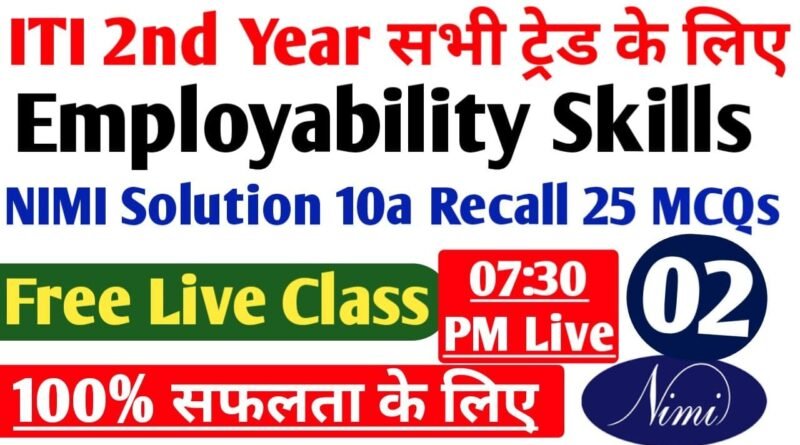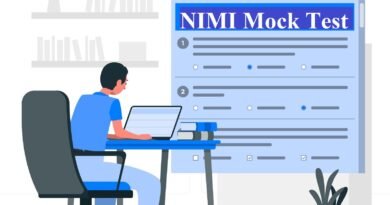ITI Employability Skills 2nd Year Modal Paper 2
ITI के द्वितीय सत्र के जितने भी ट्रेड हैं उनके लिए Employability Skills का modal पेपर है |
इसमें कुल 25 प्रश्न है |
निचे दिए गये प्रश्न आईटीआई के सेकंड इयर के लिए है |
ये NIMI के Second Year के workbook का solution है |
NIMI 2nd Year Workbook 10a Recall Solution PDF Also available
Industrial Training Institute
Employability Skills
Second Year
Chapter : English Literacy Chapter : 10a Recall
Multiple Choice Questions
1. Greetings help you to
a. establish a connection with someone you meet in formal and informal situations.
b. establish a connection with someone you meet in formal situations.
c. establish a connection with someone you meet in informal situations.
d. none
2. When you meet the instructor inside or outside the ITI, it is
a. always formal b. always informal c. formal inside the ITI d. informal outside the ITI
3. ‘Good Morning’, ‘How are you doing?’ – are examples of
a. informal greeetings b. formal greetings c. how we greet people who are close to us d. none
4. When you meet your friend in the bus stop, you will greet him/her
a. What’s up? b. What’s news? c. How’s life?’ d. all of the above
5. ‘What’s up?’, ‘How’s life?’, Good to see you – are examples of
a. formal greetings b. how to greet ITI instructors
c. informal greetings d. all of the above
6. Ayush and Akram are childhood friends. They work in different companies. They meet after a long time in the supermarket. How will they greet each other?
a. Good to see you b. Good morning c. I am pleased to meet you. d. none
7. In the context of an interview ————————————— greetings is to be used.
a. formal b. informal c. friendly d. none
8. When you make an enquiry in a bank, it is ——————————— situation.
a. an informal b. a formal c. a friendly d. all of the above
9. During the COVID-19 pandemic, it is better to ————————– than shake hands, say namaste than ————————
a. hug, wave hands b. wave hands, hug c. hold hands, hug d. none
10. Ability to introduce oneself helps to
a. meet new people b. network c. start conversations d. all of the above
11. Ability to communicate helps to
a. form bonds b. form connections c. collaborate d. all of the above
12. Self-introduction includes
a. saying your name, likes & dislikes b. about your friends and family
c. about your interests & hobbies d. all of the above
13. A good —————————————- helps to create a good first impression.
a. family b. friend c. self-introduction d. all of the above
14. We may have to introduce colleagues, peers and superiors in —————————— context.
a. self-introducion b. informal c. formal d. none
15. A quick self-introduction is called
a. elevation pitch b. elevator tone c. elevator pitch d. elevation tone
16. We can use ——————, —————, —————— to talk about our likes and dislikes.
a. love b. enjoy c. hate d. all of the above
17. When you attend a friends wedding with your father, you may have to introduce your father to your friend and and your friend to your father. What kind of a situation is it?
a. elevator pitch b. formal c. informal d. elevation tone
18. As a customer sales ececutive in an electrical appliances showroom, your greetings and introduction of your instructor to your supevisor shall be ————————–
a. descriptive b. formal c. informal d. elevator tone
19. —————————- are persons with very good behaviour, achievements and lead as an example.
a. customer service executives b. sales supervisors
c. ITI instructors d. role models
20. Role models————————— people to follow them.
a. elevate b. instruct c. inspire d. none
21. Role models inspire people to follow them though they have ———————– and have met
————————-.
a. elevation, failures b. strengths, failures
c. weaknesses, failures d. elevation, successes
22. Role models can be from
a. family b. friends c. neighbours & extended family d. all of the above
23. Role models —————————– us to ————————— their strengths that has inspired us.
a. follow, influence b. influence, inspire c. influence, follow d. influence, inspire
24. Human beings are ———————— by nature. It is the cultivation of —————— habits that makes one
a better person.
a. perfect, good b. perfect, strength c. imperfect, good d. imperfect, weak
25. The set of imperfections in a person is called ——————————
a. strengths b. elevations c. imitations d. weaknesses
Questions Solution video में हैं |
| Download NIMI 2nd Year Modal Paper 2 (10a Recall ) | PDF Download |
| NIMI 2nd Year Modal Paper 1 | View |
| NIMI 2nd Year Employability Skills Modal Paper 3 | View |
| और अधिक mock test के लिए telegram join करें | Join Telegram |



